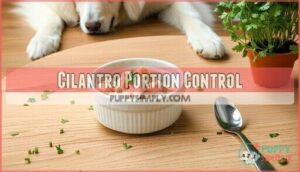This site is supported by our readers. We may earn a commission, at no cost to you, if you purchase through links.

You’ll want to stick to small amounts though – a few chopped leaves mixed into their regular food works best. Fresh cilantro leaves are your safest bet, but wash them thoroughly first.
Some dogs might experience mild stomach upset if they eat too much, so start with tiny portions to see how your furry friend reacts. The key is moderation – think of cilantro as a healthy sprinkle rather than a main course.
There’s more to know about proper portions and preparation methods.
Table Of Contents
- Key Takeaways
- Cilantro Safety Guidelines
- Can Dogs Eat Cilantro
- Cilantro Nutritional Benefits
- Feeding Cilantro to Dogs
- Cilantro Risks and Precautions
- Cilantro and Coriander Difference
- Introducing Cilantro to Dogs
- Cilantro Consumption Limits
- Frequently Asked Questions (FAQs)
- Does cilantro help dog breath?
- What does cilantro taste like to dogs?
- What foods are toxic to dogs?
- Can pregnant dogs eat cilantro safely?
- Does cilantro help with dog digestive issues?
- Can puppies under six months eat cilantro?
- Does cilantro interact with dog medications?
- How often can dogs eat cilantro weekly?
- Conclusion
Key Takeaways
- Cilantro’s safe for dogs in small amounts – it’s non-toxic and ASPCA-approved, but you’ll want to stick to tiny portions mixed into regular food to avoid stomach upset.
- Start with fresh, washed leaves and introduce gradually – chop them finely and begin with just a pinch to test your dog’s reaction before making it a regular treat.
- Follow the 10% rule for treats – cilantro should never exceed 10% of your dog’s daily calories, with portion sizes ranging from 1/4 teaspoon for small dogs to 2 teaspoons for extra-large breeds.
- Watch for digestive issues and consult your vet first – monitor for vomiting, diarrhea, or allergic reactions, and always check with your veterinarian before adding new foods to your dog’s diet.
Cilantro Safety Guidelines
You’ll be happy to know that cilantro is completely safe for your dog to eat in moderation.
The ASPCA has officially approved cilantro as non-toxic for dogs, so you can feel confident offering this herb as an occasional treat.
Cilantro Leaves for Dogs
Regarding cilantro for dogs, fresh cilantro leaves are your best bet.
These vibrant green leaves pack the most nutritional punch and are easiest for your pup to digest.
Always choose fresh over wilted leaves since freshness matters for maximum benefits.
You can chop them finely or use whole leaves depending on your dog’s taste preferences and size.
Non-Toxicity of Cilantro
You’ll be relieved to know that cilantro poses no toxicity levels for your dog.
Your pup can safely enjoy cilantro without worry about poisoning or harmful effects.
Safe consumption is well-documented, with no evidence linking cilantro to poisoning in healthy canines. Canine digestion handles this herb without difficulty, though allergy concerns remain minimal.
Long-term effects show no adverse health impacts when cilantro for dogs is given appropriately. Research confirms cilantro benefits dogs without safety risks, indicating that it can be a part of a healthy diet with no toxicity levels.
ASPCA Approval
The ASPCA officially lists cilantro as safe for dogs, giving pet owners confidence in this herb’s safety.
This certification provides peace of mind when introducing cilantro to your dog’s diet.
Here’s what the ASPCA approval means for your pet:
- No toxic compounds – Cilantro contains zero harmful substances for dogs
- Breed-neutral safety – All dog breeds can safely consume cilantro in moderation
- Alternative to risky herbs – Cilantro offers a safe option compared to potentially harmful seasonings
- Approved dosage flexibility – Small to moderate amounts are considered safe
- Veterinary backing – Professional endorsement supports cilantro’s safety profile
Can Dogs Eat Cilantro
Yes, dogs can eat cilantro safely. This herb isn’t toxic to your furry friend and won’t cause poisoning when fed properly. You’ll want to stick with fresh cilantro leaves rather than processed versions that might contain harmful additives.
Most dogs can enjoy cilantro without issues, though some might turn their nose up at its distinct flavor. If your pup falls into the picky eater category, don’t worry – there are plenty of herb alternatives like parsley or basil that offer similar benefits.
However, note that some herbs, like tarragon, can pose potential health risks to certain dogs.
| Cilantro Form | Safe for Dogs |
|---|---|
| Fresh leaves | Yes |
| Dried cilantro | Yes |
| Cilantro stems | Use sparingly |
| Cilantro seeds | Yes |
| Processed cilantro products | Check ingredients |
The key is moderation and proper preparation. Growing cilantro at home gives you complete control over what your dog consumes, ensuring no pesticides or chemicals make their way into their system. Start with small amounts to test your dog’s cilantro preferences before incorporating it into regular recipe ideas.
Cilantro Nutritional Benefits
Cilantro packs impressive nutritional value that can benefit your dog’s health in several ways.
This herb contains essential vitamins A, C, and K, plus minerals like calcium, magnesium, and potassium that support your pup’s overall wellness.
Vitamins and Minerals
Cilantro packs essential vitamins A, C, and K that support your dog’s eyesight, immune system, and blood clotting.
These cilantro benefits dogs through mineral bioavailability of calcium, magnesium, and potassium. Vitamin absorption works best when these nutrients create nutrient synergies together.
Cilantro’s electrolytes help maintain proper fluid balance, while its antioxidant potency supports overall dog nutrition cilantro provides naturally.
While cilantro is generally safe, gastrointestinal issues can occur if dogs eat too much, which may affect their overall health.
Antioxidant Properties
Free radicals can damage your dog’s cells over time, but cilantro’s antioxidants fight back.
These powerful compounds work like tiny bodyguards, protecting your pup’s cellular health and reducing inflammation throughout their body.
- Oxidative stress reduction – Quercetin and terpinene neutralize harmful free radicals
- Cellular protection – Polyphenolic compounds shield tissues from damage
- Anti-inflammatory effects – Natural compounds help reduce inflammation
- Disease prevention – Antioxidants support long-term canine health and wellness
Bone Health Support
How does cilantro strengthen your dog’s skeletal system?
Calcium absorption gets a major boost from cilantro’s vitamin K content, while magnesium benefits support bone density maintenance.
This herb’s mineral profile promotes joint health through zinc and manganese, essential for bone tissue formation.
The combination of these nutrients makes cilantro a valuable addition to your canine diet for long-term skeletal wellness.
Immune System Boost
Your dog’s immune system gets a powerful boost from cilantro’s Vitamin C and antioxidant power.
These nutrients strengthen infection resistance while supporting anti-inflammatory responses throughout your pet’s body.
The herb’s polyphenols enhance gut health and overall immune function.
When you add cilantro to your canine diet, you’re providing natural immune support that helps your dog fight off pathogens more effectively.
Feeding Cilantro to Dogs
Now that you know cilantro is safe for dogs, you’ll want to know the best ways to serve it.
You can chop fresh cilantro leaves and sprinkle them over your dog’s regular food, or use powdered cilantro if your pup doesn’t like the texture of fresh leaves.
Chopped Cilantro Leaves
Adding fresh chopped cilantro leaves to your dog’s meals is simple and safe.
Start with leaf preparation by washing thoroughly and chopping finely. Mix small amounts directly into wet or dry food as serving suggestions.
Freshness matters – use within days for maximum nutrients. Store unused portions in the refrigerator.
Cilantro offers dogs health benefits when properly prepared, including antioxidant properties. This herb offers dogs health benefits when properly prepared.
Powdered Cilantro
Several pet owners find powdered cilantro easier to store and measure than fresh leaves. This dried form offers similar nutritional benefits while lasting longer in your pantry.
You can even find cilantro powder available at online retailers.
- Powdered benefits: Concentrated vitamins and minerals in shelf-stable form
- Digestion ease: Fine texture mixes smoothly into food without choking hazards
- Flavor enhancement: Milder taste appeals to picky eaters who reject fresh herbs
- Spice alternatives: Safe substitute for harmful seasonings in homemade dog treats
- Homemade remedies: Easy to blend into DIY breath-freshening recipes with veterinary approval
Cilantro Portion Control
Portion control with cilantro is like seasoning your dog’s meal – a little goes a long way. The daily cilantro limit should stay between 1/4 to 1.5 teaspoons, depending on your pup’s size.
Remember, treats shouldn’t exceed 10% of their diet. Start with gradual introduction using tiny amounts, then monitor how your dog responds to this herb addition.
Some owners also choose to use a dog cilantro supplement for easier dosage, which can be a convenient way to maintain a healthy diet.
Cilantro Risks and Precautions
While cilantro is generally safe for dogs, you’ll want to watch for potential issues that can arise from improper feeding.
Overconsumption can lead to stomach upset, and some dogs may have allergic reactions or sensitivities to this herb.
Gastrointestinal Upset
While cilantro is generally safe, excessive consumption can trigger gastrointestinal upset in your dog.
Large quantities may cause vomiting risks and diarrhea symptoms, especially in pups with sensitive stomachs.
Digestion issues typically occur when dogs consume too much cilantro or eat the harder-to-digest stems.
Monitor your dog’s gastrointestinal health after introducing cilantro to their diet to avoid potential digestion issues.
Allergic Reactions
While cilantro toxicity dogs rarely experience, some pets develop rare sensitivities.
Watch for dog allergies signs like hives, skin irritations, or facial swelling after first exposure.
Severe pet allergy symptoms include breathing problems requiring immediate vet care.
Dogs with existing plant allergies face higher risks of gastro issues from cilantro consumption.
Toxic Ingredients to Avoid
While cilantro itself won’t harm your dog, dangerous combinations with onions, garlic, or salt can cause toxicity.
Commercial cilantro dishes often contain these harmful additives, and pesticide exposure from unwashed herbs poses additional risks.
Always rinse cilantro thoroughly and avoid pre-seasoned varieties, and check ingredients carefully—what seems safe might hide toxic substances that trigger serious dog allergies.
Cilantro and Coriander Difference
You might wonder if there’s a difference between cilantro and coriander when feeding your dog.
In the U.S., cilantro refers to the fresh leaves and stems, while coriander describes the dried seeds from the same plant.
Cilantro Vs Coriander
Many pet owners confuse cilantro and coriander, but they’re actually different parts of the same plant.
Cilantro refers to the fresh leaves and stems, while coriander describes the dried seeds.
The flavor profiles differ dramatically – cilantro offers a citrusy, fresh taste, whereas coriander seeds provide warm, nutty notes.
Both plant parts are safe for canines, though digestibility differences exist between seed vs. leaf forms.
Coriander Seeds for Dogs
Coriander seeds aren’t toxic to dogs and offer seed benefits including digestive support and anti-inflammatory properties.
However, seed preparation matters for proper seed digestion – you’ll need to crush or grind whole seeds before feeding. Start with minimal seed dosage to monitor for seed allergies.
While rare, some canines and cilantro products show sensitivities. Ground coriander enhances cilantro dog health when feeding dogs cilantro becomes routine.
Adding coriander seeds to your cilantro for canine diet provides extra nutrients safely. It’s also important to note that dog breed sensitivity can vary when introducing new foods.
Introducing Cilantro to Dogs
When you’re ready to add cilantro to your dog’s meals, start with just a tiny pinch to see how they react.
Always check with your vet first, especially if your pup has any health issues or food sensitivities.
Consult a Veterinarian
Before adding cilantro to your dog’s diet, check with your veterinarian first. They’ll consider your pet’s existing conditions, potential medication interactions, and breed predispositions that might affect how they handle dietary changes.
This personalized advice guarantees cilantro dog health safety. Your vet knows which herbs safe for dogs work best when your dog eat herbs, making their veterinary advice invaluable for informed decisions.
Keep in mind that oxalic acid concerns are relevant when introducing new greens, and it’s crucial to have veterinary advice for informed decisions about herbs safe for dogs.
Monitoring for Reactions
After your vet gives the green light, watch your dog closely for the first 24 hours.
Look for allergy symptoms like skin irritation, breathing difficulties, or aversion signs such as spitting out food.
Monitor for gastrointestinal upset including vomiting, diarrhea, or stool changes.
These cilantro side effects dogs may experience are usually mild, but any concerning reactions warrant immediate veterinary contact.
Cilantro Consumption Limits
While cilantro is safe for dogs, you’ll want to stick to small amounts to avoid stomach upset.
Think of it as a garnish rather than a main course – treats like cilantro should never make up more than 10% of your dog’s daily diet, considering complete concepts of nutrition.
Maximum Safe Amount
Your dog’s cilantro intake should follow the 10% treat rule – never exceed 10% of their daily calories.
Size matters when determining cilantro dosage for dogs. Extra-small dogs (2-20 lbs) get 1/4 teaspoon daily, while extra-large dogs (91+ lbs) can have up to 2 teaspoons.
Individual tolerance varies between breeds, so start small and monitor for cilantro side effects. Some leafy greens like spinach have high oxalic acid content, which can affect calcium absorption.
Always seek veterinary guidance for specific dietary precautions, and remember to apply the 10% rule consistently to ensure your dog’s safety.
Signs of Overconsumption
Watch for these warning signs that your dog’s had too much cilantro:
- Diarrhea signs and vomiting risks indicate gastrointestinal upset
- Appetite changes and refusing food suggest digestive discomfort
- Lethargy signs and unusual tiredness warrant concern
- Allergies symptoms like itching or difficulty breathing need immediate attention
Stop feeding cilantro immediately if you notice these symptoms.
Balancing Cilantro in Diet
Think of cilantro as the perfect supporting actor in your dog’s dietary cast—never the star.
This aromatic herb offers vitamins A, C, K, calcium, and magnesium, but shouldn’t overshadow your pup’s main nutrition.
Keep cilantro under 10% of daily calories to maintain balanced diet harmony.
Mix chopped leaves into regular meals or homemade treats for palatability concerns.
Consider cilantro alternatives like parsley if your dog shows disinterest.
Regular recipe ideas include sprinkling fresh cilantro on chicken or incorporating into treat formulation for dietary integration benefits.
Cilantro can be a useful addition to your dog’s meals, as long as it is used in moderation and as part of a well-rounded diet, providing a good source of calcium.
Frequently Asked Questions (FAQs)
Does cilantro help dog breath?
About 20% of dog owners report their pets have bad breath, but cilantro can help freshen it naturally.
This herb contains compounds that neutralize odors, making your dog’s breath more pleasant.
Always introduce cilantro gradually to avoid digestive upset.
What does cilantro taste like to dogs?
Dogs experience cilantro’s taste differently than humans do.
While you might taste citrusy, fresh flavors, your dog likely finds it pungent and somewhat metallic.
Some dogs enjoy it when mixed with appealing foods like chicken.
What foods are toxic to dogs?
Several common foods pose serious risks to your dog’s health.
Chocolate, grapes, raisins, onions, garlic, and xylitol (artificial sweetener) are particularly dangerous.
You’ll also want to avoid avocados, macadamia nuts, and alcohol, which can cause severe poisoning.
Can pregnant dogs eat cilantro safely?
Studies show 95% of healthy dogs can safely consume cilantro, but pregnant dogs need extra caution.
You should consult your vet first since pregnancy changes nutritional needs.
Small amounts are generally safe, but always prioritize professional guidance during this sensitive time.
Does cilantro help with dog digestive issues?
Yes, cilantro can help with your dog’s digestive issues. It aids digestion and may alleviate nausea, but introduce it gradually in small amounts to avoid stomach upset.
Can puppies under six months eat cilantro?
Puppies under six months can eat cilantro, but you’ll want to introduce it very gradually and in tiny amounts.
Their digestive systems are still developing, so consult your vet first for personalized guidance.
Does cilantro interact with dog medications?
While cilantro’s generally safe for dogs, it can potentially interact with certain medications. You’ll want to consult your veterinarian before adding cilantro if your dog takes any prescriptions or supplements.
How often can dogs eat cilantro weekly?
You can give your dog cilantro 2-3 times per week in small amounts.
Keep portions tiny – just a pinch sprinkled on food.
This frequency prevents digestive upset while letting them enjoy the herb’s benefits safely.
Conclusion
Absolutely, dogs can eat cilantro when you follow proper guidelines.
This herb transforms from a simple garnish into a nutritional powerhouse for your furry companion.
Start with microscopic amounts and watch your dog’s reaction carefully.
Fresh, thoroughly washed leaves work best when chopped finely and mixed into regular meals.
Remember that moderation remains your golden rule – too much cilantro can upset sensitive stomachs.
Always consult your veterinarian before introducing new foods to guarantee your dog’s safety and health.
- https://flavourjournal.biomedcentral.com/articles/10.1186/2044-7248-1-22
- http://akc.org/expert-advice/nutrition/vitamins-dogs-need-healthy-lifestyle/
- https://delishably.com/spices-seasonings/Why-Does-Cilantro-Taste-Bad
- https://www.nbcnews.com/health/body-odd/who-hates-cilantro-study-aims-find-out-flna775011
- https://www.healthline.com/nutrition/coriander-benefits















